The Utilization of Waste Water from a Concrete Plant in the Production of Cement Composites
Abstract
:1. Introduction
2. Materials and Methods
2.1. Properties of Mixing and Sludge Water from a Concrete Plant
2.2. Designed Recipes of Cement Composites
- Recipe R1—comparative recipe, consisting of 450 g of CEM I 42.5 R Hranice cement, 1350 g of standardized sand CEN EN 196-1 [24], 225 g of pure mixing water from a concrete plant source;
- Recipe R2—designed mixture consisting of 450 g of CEM I 42.5 R Hranice cement, 1350 g of standardized sand CEN EN 196-1 [24], 180 g of pure mixing water (controlled concrete plant source) and 45 g of sludge water (recycled in the concrete plant by means of recycling equipment used for STETTER agitation truck cleaning, coarse aggregate is filtered out in this water) containing a mix of admixtures from concrete produced in a concrete plant;
- Recipe R3—designed mixture consisting of 450 g of CEM I 42.5 R Hranice cement, 1350 g of standardized sand CEN EN 196-1 [24], 112.5 g of pure mixing water (controlled concrete plant source) and 112.5 g of sludge water (recycled by means of STETTER equipment in the concrete plant, which is designed to clean agitation trucks, coarse aggregate is filtered out in this water) containing a mix of admixtures from concrete produced in a concrete plant.
2.3. Tests of the Physical Characteristics of Cement Composites
2.3.1. Determination of Consistency
2.3.2. Vicat Test
2.3.3. Determination of Thermal Properties
2.3.4. Determination of Strength Characteristics
3. Results and Discussion
3.1. Cement Mortar Consistency
- 20% replacement of mixing water (R2) with waste (sludge) water from a concrete plant results in a spill value lower by 4 mm, i.e., 2.5%, in comparison with the spill value of R1 Mix (comparative);
- 50% replacement of mixing water (R3) with waste (sludge) water from a concrete plant results in a spill value lower by 22 mm, i.e., 13.7%, in comparison with the R1 Mix value (comparative).
- Replacing pure mixing water with sludge water in the amount of 20% and 50%. The dosing of the mixing water and the other components was carried out according to weight. Due to the fact that sludge water contained about 5.5% of suspended solids in 1 m3 [27], the dose of mixing water was reduced by the amount of suspended solids, which was reflected in the lower spill value.
- Increased amounts of chlorides in sludge water (183.469 mg/L). It is a known fact that chlorides are involved in shortening the beginning of the setting time.
3.2. Vicat Test of the Beginning and End of the Setting Time
- The intervals of the beginning and the end of the setting of R2 and R3 recipes were comparable, despite having different amounts of added sludge water in the mixing water, with a difference of 30%;
- After replacing 20% and 50% of pure mixing water with sludge water from a concrete plant, the values of the beginning and end times of the setting were equal;
- In comparison with the comparative Recipe R1, the setting of the mixture with sludge water is faster, namely by 15 min.
3.3. Thermal Properties of Cement Composites
- The value of the thermal conductivity coefficient λ fluctuates within the range of 2.326–2.426 W/m·K. The measured values show that the increasing substitution of mixing water with sludge water from a concrete plant is associated with a decreasing value of the thermal conductivity coefficient λ. The thermal conductivity coefficient λ in case of R2 and R3 recipes is lower by 1.6% and 4.1% in comparison with the comparative recipe R1;
- The specific volumetric heat capacity cp is within the range of 1.79–1.88·106 J/m3∙K;
- The thermal conductivity value was within the range of 1.267–1.297·106 m2/s.
3.4. Test Results of the Strength Characteristics of Cement Composites
- Higher content of chlorides in sludge water (183.469 mg/L). It is a known fact that chloride-containing concrete additives are highly effective in the hardening process, but they also shorten the beginning and the setting time of fresh concrete mix. The main disadvantage of chloride-based additives is their highly corrosive effect on steel reinforcement, which means they are not suitable for application in the production of reinforced concrete elements and structures.
- Higher amount of suspended solids in sludge water from a concrete plant, which amounts to about 60 kg (5.5%) in 1 m3 [28].
- kalcit—CaCO3, hardness 3, density is 2.7 g/cm3,
- bassanite—CaSO4·0.5H2O, hydrates togypsum, density is 2.5–2.7 g/cm3,
- quartz—SiO2, hardness 7, density 2.6 g/cm3, soluble in hydrofluoric acid,
- portlandite—Ca(OH)2, hardness 2.5–3, density 2.26 g/cm3,
- oligoclase An16—(Ca,Na)(Al,Si)4O8, hardness 6–6.5, density 2.65 g/cm3,
- chloriteIIb—(Mg,Fe)6 (Si,Al)4O10 (OH)8, hardness-, density 2.5 g/cm3,
- muscovite—KA2(AlSi3O10)(F,OH)2, hardness 4, density 2.76–3 g/cm3,
- orthoclase—KAlSi3O8, hardness 6, density g/cm3,
- anhydrite—CaSO4, hardness 3.5, density 2.95 g/cm3,the highest content was found in the last sample,
- sylvite—KCl, hardness 2, density 1.49 g/cm3.
4. Conclusions
- decrease the value of cement mortar consistency in case of 20% substitution of mixing water by 2.5%, and by 14% in case of 50% substitution;
- accelerate the initial setting by about 15 min in comparison with the initial setting when pure mixing water is used;
- reduce the value of the thermal conductivity coefficient λ of hardened cement composite by approx. 1.5% in case of 20% substitution and by approx. 4% in case of 50% substitution;
- increase the flexural strength and compressive strength at the end of the beams after seven days;
- equal the flexural strength after 28 days of age of the test specimens;
- increase the compressive strength at the end of the beams after 28 days of age of the test specimens.
Acknowledgments
Author Contributions
Conflicts of Interest
References
- Su, N.; Miao, B.; Liu, F.S. Effect of wash water and underground water on properties of concrete. Cem. Concr. Res. 2002, 32, 777–782. [Google Scholar] [CrossRef]
- Sandrolini, F.; Franzoni, E. Waste wash water recycling in ready-mixed concrete plants. Cem. Concr. Res. 2001, 31, 485–489. [Google Scholar] [CrossRef]
- Chatveera, B.; Lertwattanaruk, P. Use of ready-mixed concrete plant sludge water in concrete containing an additive or admixture. J. Environ. Manag. 2009, 90, 1901–1908. [Google Scholar] [CrossRef] [PubMed]
- Asadollahfardi, G.; Asadi, M.; Jafari, H.; Moradi, A.; Asadollahfardi, R. Experimental and statistical studies of using wash water from ready-mix concrete trucks and a batching plant in the production of fresh concrete. Constr. Build. Mater. 2015, 98, 305–314. [Google Scholar] [CrossRef]
- Ruzinski, N.; Tsimas, S.; Zervaki, M. Reuse of waste water from ready-mixed concrete plants. Manag. Environ. Qual. Int. J. 2011, 22, 7–17. [Google Scholar] [CrossRef]
- Kazaz, A.; Ulubeyli, S. Current Methods for the Utilization of the Fresh Concrete Waste Returned to Batching Plants. Procedia Eng. 2016, 161, 42–46. [Google Scholar] [CrossRef]
- Ferrari, G.; Miyamoto, M.; Ferrari, A. New sustainable technology for recycling returned concrete. Constr. Build. Mater. 2014, 67, 353–359. [Google Scholar] [CrossRef]
- Xuan, D.; Zhan, B.; Poon, C.S.; Zheng, W. Innovative reuse of concrete slurry waste from ready-mixed concrete plants in construction products. J. Hazard. Mater. 2016, 312, 65–72. [Google Scholar] [CrossRef] [PubMed]
- Frišták, V.; Pipiška, M.; Horník, M.; Augustín, J.; Lesný, J. Sludge of wastewater treatment plants as Co2+ ions sorbent. Chem. Pap. 2013, 67, 265–273. [Google Scholar] [CrossRef]
- Ortega, J.M.; Esteban, M.D.; Rodríguez, R.R.; Pastor, J.L.; Sánchez, I. Microstructural Effects of Sulphate Attack in Sustainable Grouts for Micropiles. Materials 2016, 9. [Google Scholar] [CrossRef]
- Chalee, W.; Ausapanit, P.; Jaturapitakkul, C. Utilization of fly ash concrete in marine environment for long term design life analysis. Mater. Des. 2010, 31, 1242–1249. [Google Scholar] [CrossRef]
- Pastor, J.L.; Ortega, J.M.; Flor, M.; López, M.P.; Sánchez, I.; Climent, M.A. Microstructure and durability of fly ash cement grouts for micropiles. Constr. Build. Mater. 2016, 117, 47–57. [Google Scholar] [CrossRef]
- Chalee, W.; Jaturapitakkul, C.; Chindaprasirt, P. Predicting the chloride penetration of fly ash concrete in seawater. Mar. Struct. 2009, 22, 341–353. [Google Scholar] [CrossRef]
- Ortega, J.M.; Sánchez, I.; Antón, C.; De Vera, G.; Climent, M.A. Influence of environment on durability of fly ash cement mortars. ACI Mater. J. 2012, 109, 647–656. [Google Scholar]
- Bijen, J. Benefits of slag and fly ash. Constr. Build. Mater. 1996, 10, 309–314. [Google Scholar] [CrossRef]
- Thomas, M.D.; Matthews, J. Performance of pfa concrete in a marine environment—10 year results. Cem. Concr. Compos. 2004, 26, 5–20. [Google Scholar] [CrossRef]
- Borger, J.; Carrasquillo, R.L.; Fowler, D.W. Use of recycled wash water and returned plastic concrete in the production of fresh concrete. Adv. Cem. Based Mater. 1994, 1, 267–274. [Google Scholar] [CrossRef]
- Abd El-Aziz, M.A.; Sufe, W.H. Effect of sewage wastes on the physico-mechanical propertiesof cement and reinforced steel. Ain Shams Eng. J. 2013, 4, 387–391. [Google Scholar] [CrossRef]
- Kadir, A.A.; Shahidan, S.; Lau, H.Y.; Hassan, M.H.; Abdullah, M.; Bakri, M.A. The effect on slurry water as a freshwater replacement in concrete properties. IOP Conf. Ser. Mater. Sci. Eng. 2016, 133, 12041–12049. [Google Scholar] [CrossRef]
- Al-Jabri, K.S.; AL-Saidy, A.H.; Taha, R.; AL-Kemyani, A.J. Effect of using Sludge water on the Properties of High Strength Concrete. Procedia Eng. 2011, 14, 370–376. [Google Scholar] [CrossRef]
- Ladomerský, J.; Janotka, I.; Hroncová, E.; Najdená, I. One-year properties of concrete with partial substitution of natural aggregate by cupola foundry slag. J. Clean. Prod. 2016, 131, 739–746. [Google Scholar] [CrossRef]
- Hybska, H.; Hroncova, E.; Ladomersky, J.; Balco, K.; Mitterpach, J. Ecotoxicity of Concretes with Granulated Slag from Gray Iron Pilot Production as Filler. Materials 2017, 10, 505. [Google Scholar] [CrossRef] [PubMed]
- Mixing Water for Concrete—Specification for Sampling, Testing and Assessing the Suitability of Water, Including Water Recovered from Processes in the Concretein Dustry, as Mixing Water For Concrete; ČSN EN 1008; Czech Office for Standards, Metrology and Testing: Praha, Czech Republic, 2003.
- Methods of Testing Cement—Part 1: Determination of Strength; ČSN EN 196-1; Czech Office for Standards, Metrology and Testing: Praha, Czech Republic, 2016.
- Methods of Test for Mortar for Masonry—Part 3: Determination of Consistence of Fresh Mortar (by Flow Table); ČSN EN 1015-3; Czech Office for Standards, Metrology and Testing: Praha, Czech Republic, 2008.
- Methods of Testing Cement—Part 3: Determination of Setting Times and Soundness; ČSN EN 196-3 + A1; Czech Office for Standards, Metrology and Testing: Praha, Czech Republic, 2008.
- Klus, L.; Václavík, V.; Dvorský, T.; Svoboda, J.; Papesch, R. The properties of waste water from a concrete plant. IOP Conf. Ser. Earth Environ. Sci. 2017, 92, 012028–012032. [Google Scholar] [CrossRef]
- Admixtures for Concrete, Mortar and Grout—Test Methods; ČSN EN 480-11; Czech Office for Standards, Metrology and Testing: Praha, Czech Republic, 2006.
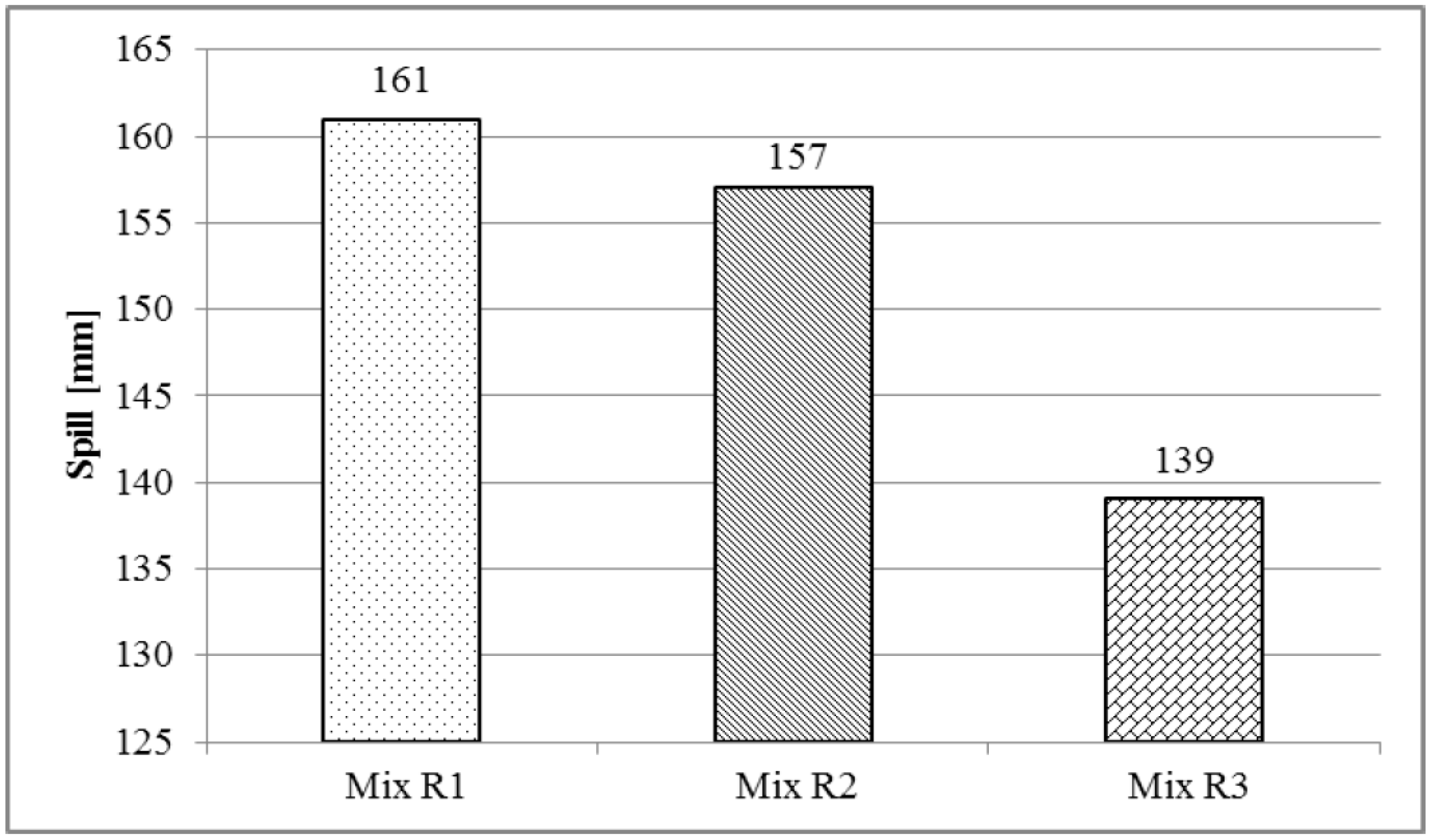
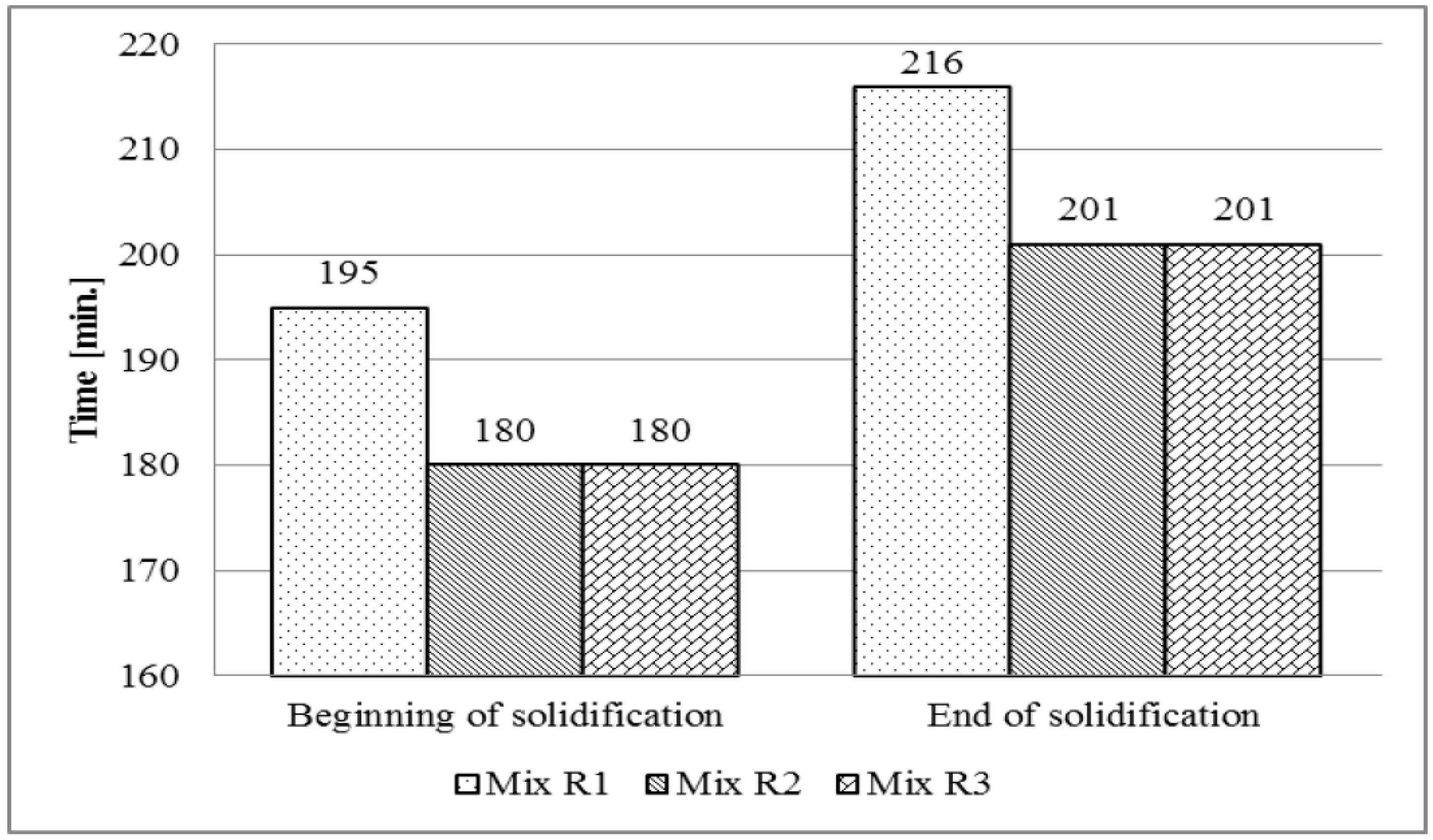
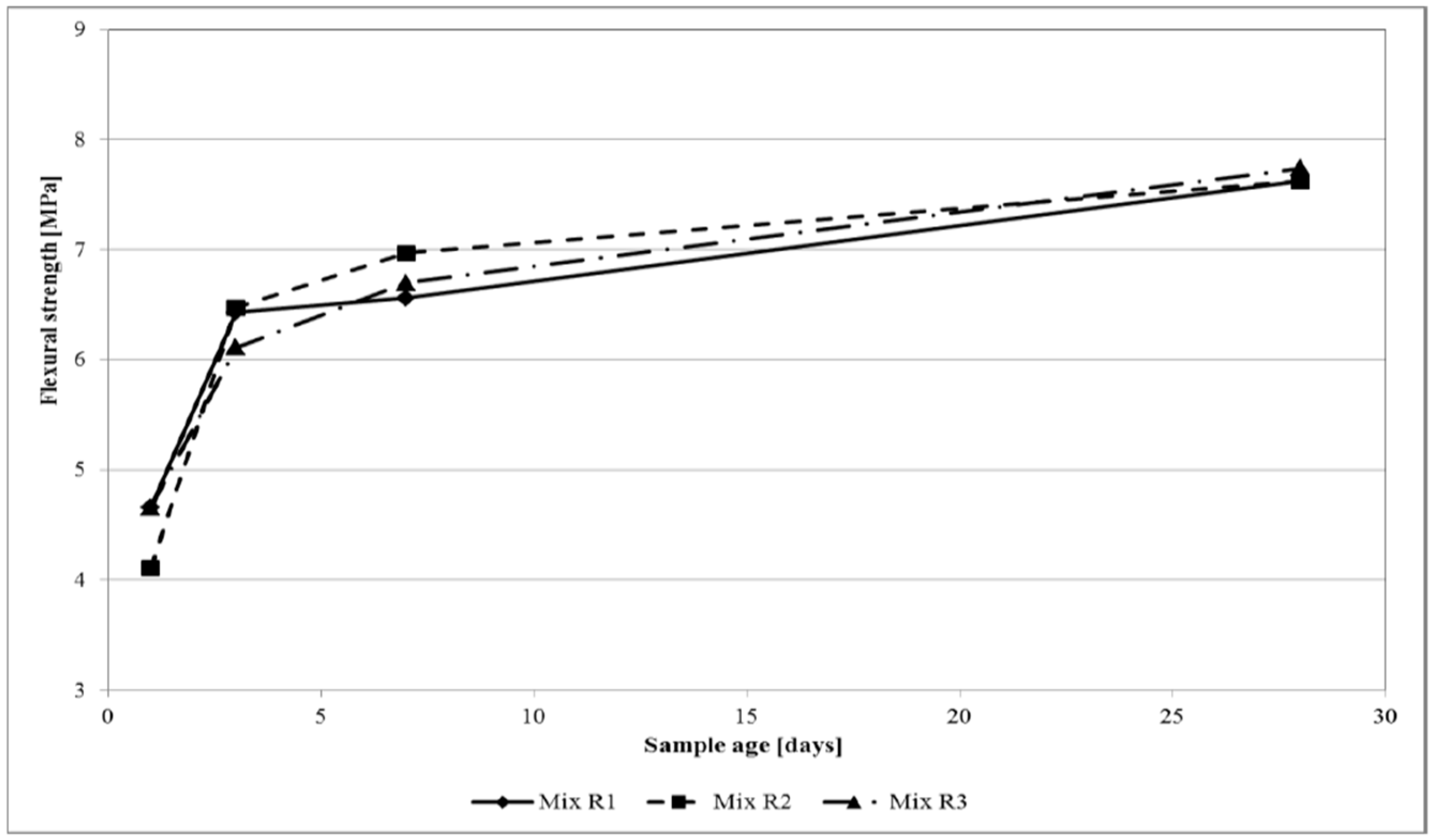

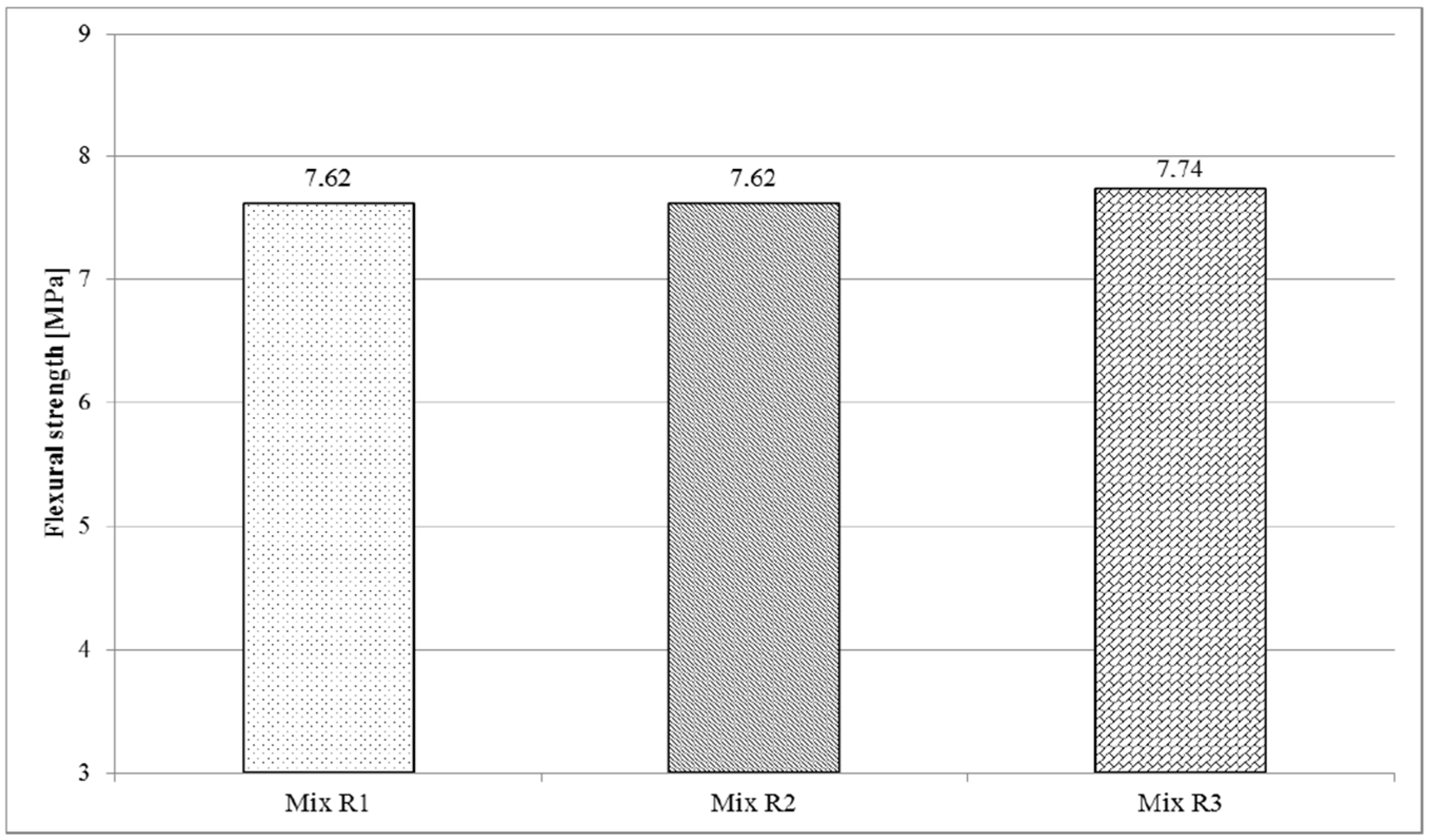
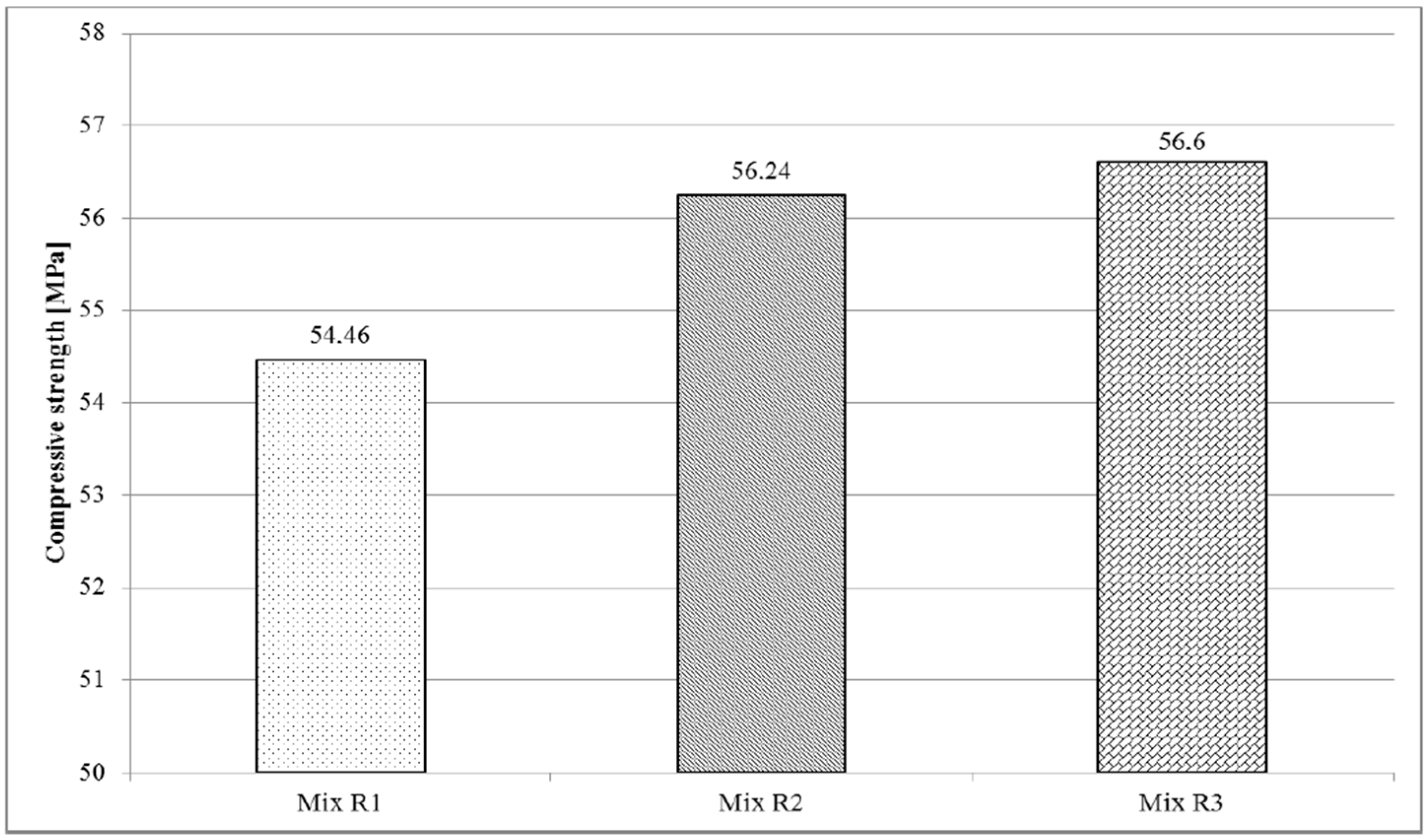
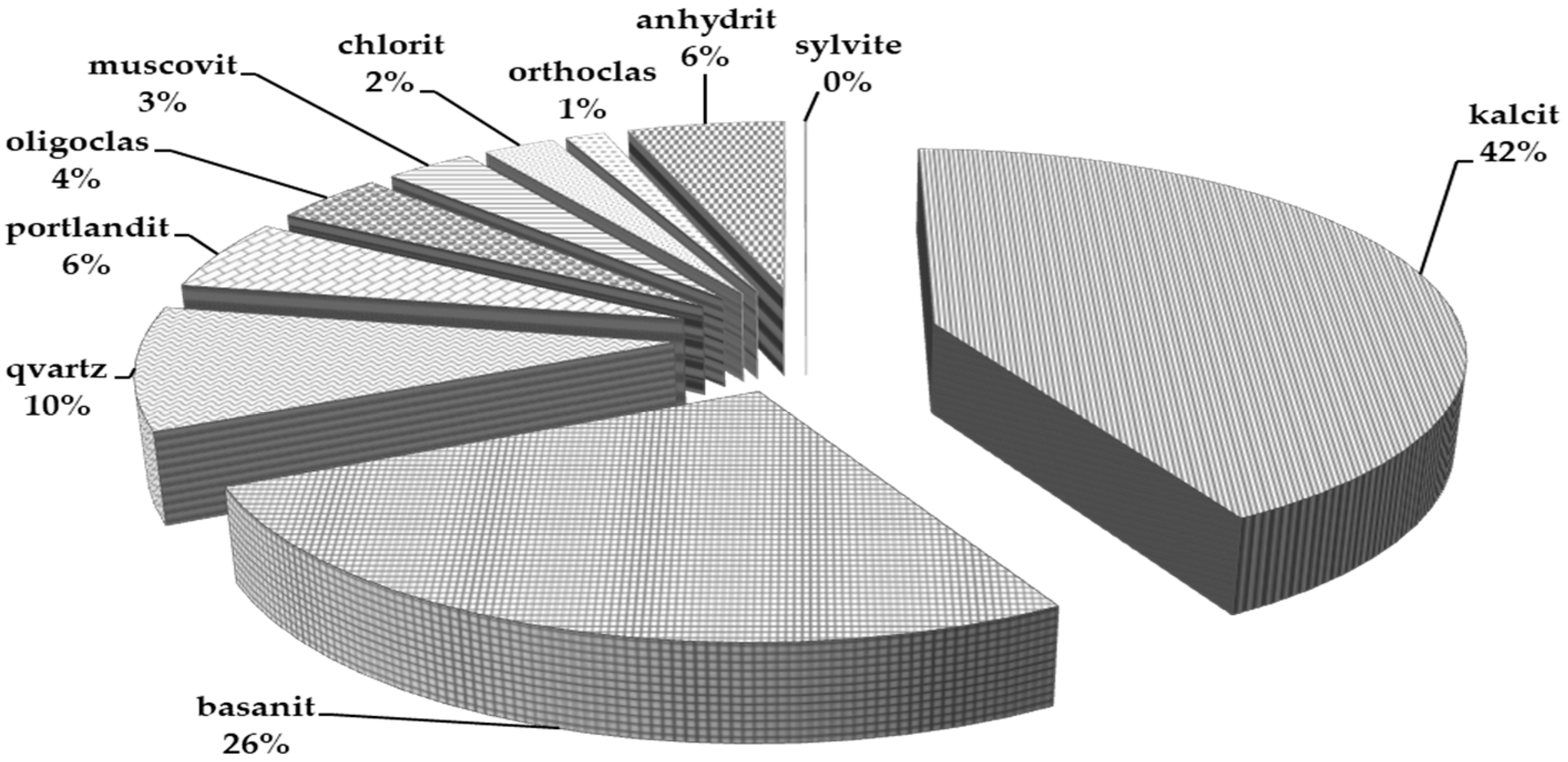
| Tested Properties | Pure Mixing Water from a Concrete Plant | Sludge Water from a Concrete Plant | Limit Concentrations According to ČSN EN 1008 |
|---|---|---|---|
| pH | 6.774 | 12.538 | >4 |
| Temperature | 18.5 °C | 18.5 °C | - |
| Conductivity | 336.12 µS/cm | 13.39 µS/cm | - |
| Humus substances | acceptable | acceptable | paler than yellow-brown |
| Chlorides | 14.182 mg/L | 183.469 mg/L | <600 <2000 <4500 mg/L |
| Sulphates | 40.268 mg/L | 1702.1 mg/L | <2000 mg/L |
| Nitrates | 9.4 mg/L | - | <500 mg/L |
| CHSKCr | 5.236 mg/L | - | - |
| Na | 31.326 mg/L | 135 mg/L | <1000 mg/L |
| Pb | 0 mg/L | 0.1864 mg/L | <100 mg/L |
| Zn | 0.0606 mg/L | 0.0264 mg/L | <100 mg/L |
| Ca | 33.18 mg/L | 1114.4 mg/L | - |
| Glucose = sucrose | <100 + <100 mg/L | <100 + <100 mg/L | <100 + <100 mg/L |
| Sample | R1 | R2 | R3 | |||
|---|---|---|---|---|---|---|
| d1 (mm) | d2 (mm) | d1 (mm) | d2 (mm) | d1 (mm) | d2 (mm) | |
| Diameter | 155.00 | 166.00 | 156.50 | 156.50 | 138.00 | 140.00 |
| Spill (mm) | 161 | 157 | 139 | |||
| Recipe | Beginning of Setting (min) | End of Setting (min) |
|---|---|---|
| R1 | 195 | 216 |
| R2 | 180 | 201 |
| R3 | 180 | 201 |
| Recipe | Sample Age (Days) | Thermal Conductivity Coefficient λ (W/m·K) | Specific Volumetric Heat Capacity cp∙106 (J/m3∙K) | Thermal Conductivity 10−6 (m2/s) |
|---|---|---|---|---|
| R1 | 28 | 2.426 | 1.87 | 1.296 |
| R2 | 28 | 2.386 | 1.88 | 1.267 |
| R3 | 28 | 2.326 | 1.79 | 1.297 |
| Recipe | Sample Age (Days) | Flexural Strength | Compressive Strength |
|---|---|---|---|
| Rf (MPa) | Rc (MPa) | ||
| R1 | 1 | 4.66 | 22.79 |
| R2 | 4.11 | 21.45 | |
| R3 | 4.66 | 24.49 | |
| R1 | 3 | 6.43 | 39.90 |
| R2 | 6.47 | 38.39 | |
| R3 | 6.11 | 39.98 | |
| R1 | 7 | 6.56 | 45.94 |
| R2 | 6.97 | 48.74 | |
| R3 | 6.70 | 50.94 | |
| R1 | 28 | 7.62 | 54.46 |
| R2 | 7.62 | 56.24 | |
| R3 | 7.74 | 56.61 |
© 2017 by the authors. Licensee MDPI, Basel, Switzerland. This article is an open access article distributed under the terms and conditions of the Creative Commons Attribution (CC BY) license (http://creativecommons.org/licenses/by/4.0/).
Share and Cite
Klus, L.; Václavík, V.; Dvorský, T.; Svoboda, J.; Papesch, R. The Utilization of Waste Water from a Concrete Plant in the Production of Cement Composites. Buildings 2017, 7, 120. https://doi.org/10.3390/buildings7040120
Klus L, Václavík V, Dvorský T, Svoboda J, Papesch R. The Utilization of Waste Water from a Concrete Plant in the Production of Cement Composites. Buildings. 2017; 7(4):120. https://doi.org/10.3390/buildings7040120
Chicago/Turabian StyleKlus, Lukáš, Vojtěch Václavík, Tomáš Dvorský, Jakub Svoboda, and Radek Papesch. 2017. "The Utilization of Waste Water from a Concrete Plant in the Production of Cement Composites" Buildings 7, no. 4: 120. https://doi.org/10.3390/buildings7040120







